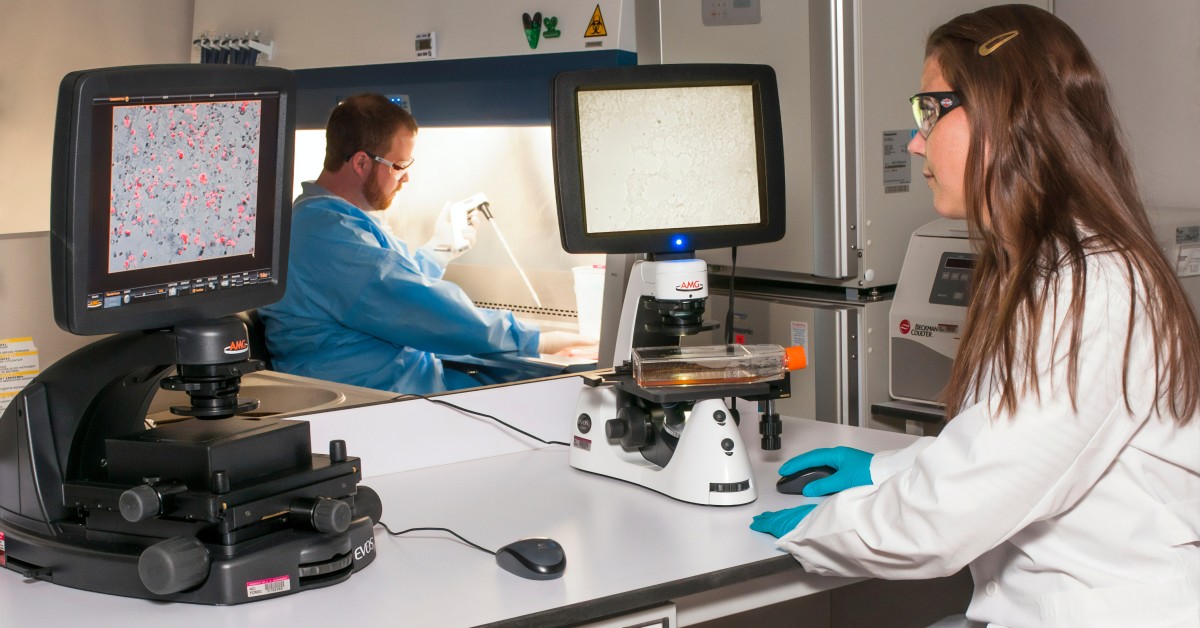
Information Architect vs. Data Architect [Difference Explained]
If you're deciding between data and information architecture, money likely [...]

Experts predict humans will generate 175 zettabytes of digital information by 2025. That’s one trillion gigabytes.
Memes, videos of cute cats, and doom-scrolling fodder make up only a small percentage of that data. There’s also business data and healthcare data, scientific data, and real-time data. Our IRL movements and digital habits are continually being translated into more, and more precise, data points.
There are actionable insights hidden in the vast quantities of information generated each day. Multiple disciplines have sprung up as part of our quest to uncover those insights. Data analytics is a relatively old field, one that traditionally looked at historical data to find trends that can answer questions about what’s happening in the present. Data science is a relatively new discipline that looks at historical and present-day data to make predictions about what will happen in the future.
Analytics was once the dependable workhorse used for sifting through simple structured data, while data science was the niche tool for analyzing unstructured information. Increasingly, however, the distinction between these two disciplines is whatever employers and institutions of higher learning say it is. Choosing between them can be tricky—so tricky that you’re better off comparing individual university programs and job postings than trying to rely on degree naming conventions or titles alone.
This article summarizes the differences where they exist to help you get started on your journey. We look at data analytics vs. data science and cover:
Analytics uses techniques from statistics, business intelligence, and information science to collect, organize, and analyze data. Data analysts typically turn their findings into dashboards, visualizations, and reports for stakeholders. They may or may not make actionable recommendations based on those findings. That depends on the scope of their role.
Data analytics aims to improve organizational performance and solve business problems using facts, not feelings or hunches. Data analytics can explain past and current performance, identify performance roadblocks, and (sometimes) predict future outcomes. What it often can’t do is deal with large amounts of unstructured data.
Analysts usually have strong skills in database querying languages like SQL and statistical programming languages such as R and Python. They’re also typically domain experts. According to one University of Pennsylvania Wharton Stories feature, “What someone does with analytics within finance (quantitative trading) will be entirely different from what someone might do with analytics in tech… Even the most advanced data scientist won’t be able to get a job at a fintech firm without a solid understanding of the core principles of trading.”
| University and Program Name | Learn More |
|
Boston College:
Master of Science in Applied Analytics
|
|
|
Merrimack College:
Master of Science in Data Science
|
Data scientists do everything data analysts do and more. According to University of California – Berkeley, data scientists “identify relevant questions, collect raw data from a multitude of different data sources, organize the information, translate results into solutions, and communicate their findings in a way that positively affects business decisions.”
Data science can deal with large datasets, and the questions data scientists have to answer are more complex. That’s why data scientists use not only statistical models and information science, but also software engineering, machine learning, deep learning, mathematics, and computer science to derive their answers—and to make useful predictions about future outcomes (something analytics doesn’t typically do).
Analytics master’s degrees are becoming the new normal in the field. Burtch Works found that 89 percent of data analysts with less than three years of experience have graduate degrees. The answer to the question ‘Is a master’s in analytics worth it?’ is clearly yes.
Analytics degrees are comparatively rare at the undergraduate level and may be getting rarer as colleges and universities convert their analytics bachelor’s programs into data science programs. Most data analysts have degrees in statistics, finance, mathematics, computer science… or data science.
Most Bachelor of Science in Data Analytics programs have the same admission requirements as other undergrad programs. Admissions officers want to see good grades and personal attributes showing applicants can handle college-level work. They also look for candidates who can explain their rationale for choosing this major.
Earning a bachelor’s degree in data analytics typically takes four years unless you bring in transfer credits, in which case you’ll finish more quickly, or study part-time, in which case you’ll finish more slowly.
The best way to get a feel for the typical bachelor’s-level data analytics curriculum is to look at a real-world example. For instance, New York University (NYU) has a 128-credit BS in Applied Data Analytics and Visualization program that teaches “broad-based skills in information systems, quantitative and qualitative analysis, and data visualization.” In addition to core liberal arts courses in writing, history, and science, analytics majors take classes like:
Graduate-level analytics programs often focus on “advanced analytics” and have more in common with data science programs than with older, less technical business intelligence programs. Of all the reasons to get a Master of Science in Data Analytics (MSDA) or a master’s in business analytics like the one offered by Tulane University of Louisiana, the average master’s in data analytics salary is probably at the top. It takes many master’s in data analytics graduates less than two years to recover the cost of a master’s program plus lost earnings. Graduate from one of the least expensive MSDA programs, and you may recoup your investment faster.
Admissions officers look for candidates with academic or professional backgrounds in information systems, computer science, analytics, or statistics. They also want to see basic programming skills. You only need to know one programming language to apply to Tufts University‘s MSDA program.
Most of the top MSDA programs require full-time students to complete about 30 credit hours of coursework over two years. Part-time students can take three or more years to earn an analytics master’s, while students who take classes year-round may be able to earn this degree in just 12 to 15 months.
Coursework in on-campus and online MSDA programs typically covers:
Very few colleges and universities offer a doctorate in data analytics—possibly because this degree isn’t necessary unless you plan to go into research or academia. It’s doubtful you’ll need a PhD in a corporate setting.
Good grades and competitive GRE or GMAT scores are a must-have, along with a bachelor’s degree in a discipline related to data analytics. Applicants also need to show they have a distinct area of research interest and the academic and professional experience necessary to conduct that research.
The length of data analytics PhD programs varies not only by school but also from student to student. You might be able to complete the required coursework in just one or two years, but your dissertation research may take much longer.
The curriculum in many analytics PhD programs is student-led, meaning students work with faculty advisors to create a unique plan of study. You might, however, take classes like:
A whopping 90 percent of data scientists have advanced degrees. The Master of Science in Data Science (MSDS) is considered an entry-level degree in data science; 46 percent of data scientists have PhDs. The answer to the question ‘Do I need a master’s in data science?’ is an unequivocal yes.
Undergraduate data science degrees are still uncommon, so many people launch data science careers with degrees in computer science or mathematics. However, if you know your future lies in data science, majoring in it is a smart idea.
Data science programs tend to look for applicants with strong grades and SAT or ACT scores, plus extracurricular experiences centered around computer science, programming, or technology.
Like most undergraduate programs, full-time Bachelor of Science in Data Science (BSDS) programs last four years, during which students typically complete core coursework plus a project, an internship, or both.
The BSDS program at Tufts University is pretty typical when it comes to core coursework. Students take liberal arts classes plus courses covering topics like:
As Stevens Institute of Technology puts it in the guide to its online MS in Data Science program, earning a data science master’s prepares students for “careers in fintech, business intelligence and analytics, academia, and database management, as well as government positions requiring strong skills in data analysis.”
Admission into the top data science master’s programs (including the top online MSDS programs) is highly competitive. Most students have extensive professional or research experience in data analytics, business intelligence, statistical mathematics, or related fields.
Like most technical graduate degree programs, data science master’s programs commonly take two years of full-time study to complete. Accelerated data science master’s programs are rare because these programs cover so much ground.
The University of Virginia‘s online Master of Science in Data Science program offers a good example of a typical curriculum. Students take courses like:
Many data scientists have doctoral degrees—not just in research and academia, but in the corporate world, too. You should consider earning a doctorate if you want to advance in this field.
Data science doctorate programs are usually small and highly competitive. Successful applicants typically have extensive professional or research experience plus one or more graduate degrees in mathematics, statistics, computer science, or engineering.
Most doctoral-level data science programs require students to complete anywhere from 30 to 70 credits of coursework (depending on the program and the candidate’s prior coursework) plus original research and a dissertation. While students may finish taking the required classes in two years, they may take five years or more to complete their project work.
Data science doctorate coursework covers topics like data science theory, applied computer science, advanced statistics, and ethics. However, it’s usually up to the student to design a program of study based on their research.
The answer depends on who is asking the question. Data science is advanced analytics, and analysts and data scientists use many of the same techniques and tackle many of the same kinds of challenges in their work. The distinction between these two disciplines is growing hazier as data sets grow larger and organizations expect to glean more from the data they generate. In response, analytics programs incorporate more heavy programming, data mining principles, and machine learning algorithms into curricula—further narrowing the gulf.
Jobs for data analysts go by many titles. After earning a degree in data analytics, you might step into or advance into any of the following roles:
How much you’ll earn if you become a data analyst will depend on various factors, from your education to your title to your location. The average data analyst earns about $61,000, but the average salary associated with an MS in Data Analytics is just over $77,000. Senior data analysts earn more than $80,000.
Top companies hiring data analysts include:
There are many roles in data science beyond ‘data scientist’. After earning a data science master’s, you might have any of the following titles:
Sources report data science professionals earn anywhere from $96,000 to $123,000, but the most recent Robert Half Technology Salary Guide predicts the median salary for data science roles in 2021 will be about $129,000. That suggests the ROI of a data science degree is pretty good—especially given there are many affordable data science degree programs (including affordable online data science master’s programs) out there.
According to Diffbot’s State of Data Science, Engineering & Artificial Intelligence Report, these companies have the largest data-related workforces:
The difference between data science and data analytics isn’t as clear-cut as it once was—largely thanks to employers. Kashyap Dalal, Chief Business Officer at Simplilearn, has seen startups “actually use data scientist as a fancy designation to attract talent for their analyst roles.” Some job listings ask that analysts have machine learning skills and experience with predictive models, so it’s not surprising analytics degrees often lead to data science careers. That means you may not have to choose one discipline or the other. More and more MSDA programs are teaching “advanced analytics,” so chances are even if you study analytics today, you may end up becoming a data scientist tomorrow.
(Last Updated on February 26, 2024)
Questions or feedback? Email editor@noodle.com

If you're deciding between data and information architecture, money likely [...]

Health informatics and health analytics aren't that different,at least as [...]

Data scientists and software engineers both code, but what they [...]

Some schools and employers use the terms health informatics and [...]

Health informatics is sometimes called biomedical informatics, which sounds a [...]
Categorized as: Data Science, Information Technology & Engineering